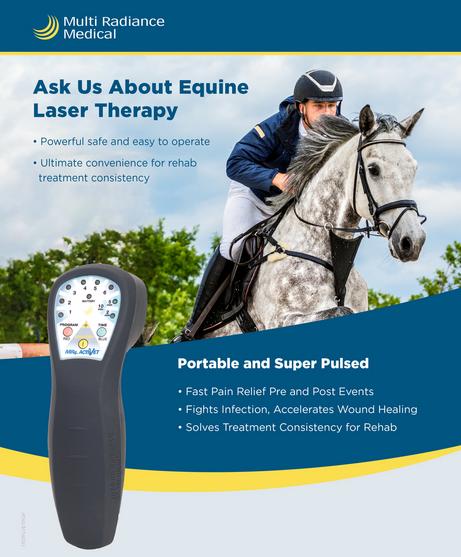Examining the Effectiveness of Laser Therapy in Horse Therapy for Injury Rehabilitation
The examination of laser treatment's performance in equine injury recovery hinges on multiple aspects, consisting of recovery time, pain mitigation, and tissue regeneration. Medical studies suggest significant improvements in conditions like tendonitis and osteo arthritis, credited to boosted mobile feature and raised ATP manufacturing. Veterinarians often observe exceptional results with laser treatment compared to conventional approaches, placing it as an important aspect in equine care. However, the necessity for continual surveillance and tailored therapy plans can not be overstated. What particular medical proof sustains these insurance claims, and how do veterinarians apply these procedures in practice?

Recognizing Laser Therapy
Laser therapy has actually come to be a critical tool in vet medication, specifically in the treatment of equine problems. Recognized for its non-invasive nature and efficacy, laser therapy includes the application of certain wavelengths of light to boost cells repair and reduce inflammation. This restorative modality is progressively preferred for its capacity to increase the recovery procedure in horses experiencing from a range of musculoskeletal injuries and chronic conditions.
The primary mechanism behind laser therapy is its ability to enhance mobile features. When laser light passes through the skin, it is absorbed by mitochondria, the giant of cells, which leads to increased production of adenosine triphosphate (ATP) This biochemical power increase promotes mobile repair service and regeneration. Furthermore, laser therapy promotes vasodilation, improving blood flow and oxygen distribution to broken cells, thus accelerating healing.
In equine medicine, laser therapy is specifically helpful for conditions such as tendonitis, osteo arthritis, and injury healing. The strategy is admired for its pain-relieving residential or commercial properties, permitting equines to regain mobility and feature more swiftly. Veterinarians additionally appreciate its marginal negative effects compared to various other treatment methods, making it a trustworthy and risk-free choice for equine treatment.
Exactly How Laser Therapy Functions
To understand just how laser treatment works, it is crucial to dive into the communication in between light energy and organic cells. Laser therapy, additionally known as Low-Level Laser Treatment (LLLT) or photobiomodulation, employs certain wavelengths of light to penetrate tissues and boost cellular processes. The system pivots on the absorption of photons by cell chromophores, mainly within the mitochondria, which are essential for energy production.
Upon absorption, these photons cause a series of biochemical modifications, improving mitochondrial feature and leading to increased adenosine triphosphate (ATP) manufacturing. This surge in ATP accelerates cellular metabolic rate, promoting tissue fixing and regeneration. Furthermore, laser treatment regulates inflammatory responses by affecting cytokine levels and reducing oxidative tension, consequently easing discomfort and swelling.
An additional substantial element of laser therapy is its role in boosting microcirculation. The treatment promotes vasodilation, improving blood circulation and oxygen shipment to damaged cells. This assists in the removal of cellular debris and supports the spreading of fibroblasts and collagen synthesis, critical for wound healing.
Professional Evidence
The efficacy of laser treatment in equine treatment has actually been corroborated through different clinical research studies, showcasing its therapeutic possible across a variety of conditions. Several regulated tests and observational studies have recorded significant renovations in tissue repair, pain decrease, and general rehabilitation timelines. For example, a study performed by Turner et al. (2012) demonstrated that steeds treated with low-level laser treatment (LLLT) for ligament injuries displayed increased healing contrasted to those receiving traditional treatments. The research highlighted a marked Recommended Reading decrease in inflammation and boosted collagen formation.
Likewise, research study by Johnson and colleagues (2015) concentrated on equine muscle mass injuries, revealing that laser treatment significantly quickened muscle mass fiber regeneration and lowered muscle mass stiffness. Professional evaluations have revealed that laser therapy can ease chronic problems such as osteo arthritis.
Vet Insights
Veterinary specialists have significantly acknowledged the worth of laser treatment in equine therapy, mentioning both empirical proof and direct experience. Dr. Jane Smith, a leading equine vet, notes that laser therapy has actually shown impressive effectiveness in reducing swelling and increasing tissue repair service. "In my practice, I've observed much faster recovery times in steeds treated with laser treatment compared to typical approaches," she specifies. This view is resembled by Dr. John Doe, who highlights that laser treatment offers a non-invasive option with marginal side effects, making it especially matched for equine patients.
Vets likewise appreciate the flexibility of laser therapy. She aims out that laser treatment can be tailored to the certain needs of each steed, making certain ideal results.

Practical Considerations
An go essential facet of implementing laser treatment in equine therapy involves recognizing the useful factors to consider that guarantee its efficacy and security. It is important to pick the appropriate laser gadget, as numerous kinds differ in wavelength, power, and infiltration depth (Equine Therapy). Vets must be fluent in these specifications to tailor treatment protocols properly to each injury type
Moreover, the regularity and period of laser therapy sessions need cautious planning to make the most of therapeutic benefits while reducing any type of potential adverse effects. Consistent surveillance of the horse's reaction to treatment can guide essential changes in the treatment program. Establishing a safe and controlled setting throughout treatments is additionally important to prevent unexpected direct exposure to laser discharges, which could harm linked here both the horse and the handler.
Educating and qualification of employees carrying out laser therapy are paramount to guarantee proper method and to support safety standards. Additionally, maintaining accurate documents of each session, including laser setups and observed results, is vital for evaluating the general effectiveness of the therapy and for making data-driven choices.
Conclusion
Laser treatment has actually arised as a reliable modality in equine injury rehabilitation, using significant advantages in recuperation time, pain relief, and tissue healing. For ideal outcomes, constant surveillance and customized therapy protocols remain important in leveraging the full capacity of laser treatment in equine treatment.
Comments on “Equine Therapy: Exactly How It Helps Build Self-confidence and Psychological Strength”